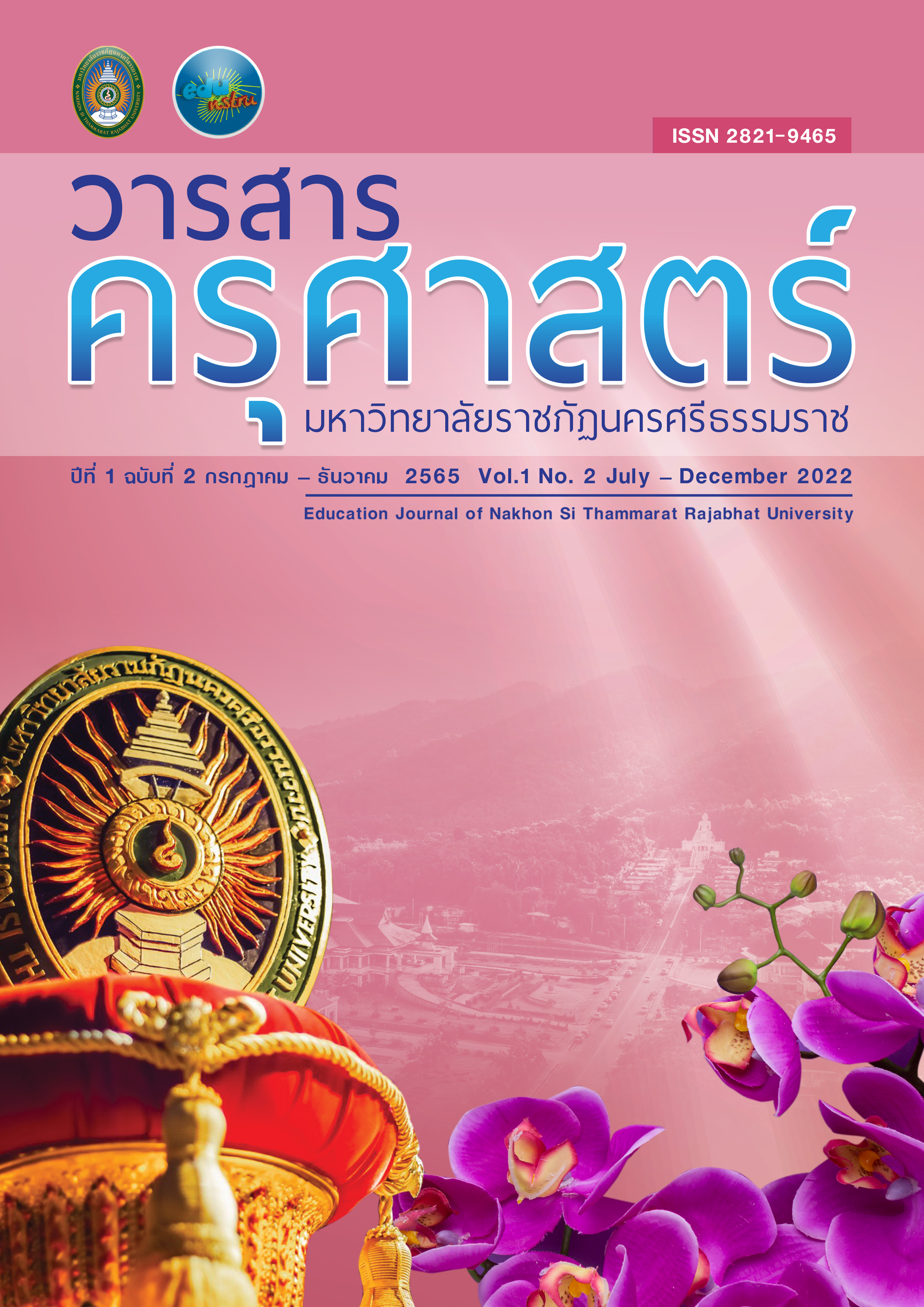Mathematical Problem Solving Ability on Set for Mathayomsuksa 4 Students in Classroom Using Open Approach
Main Article Content
Abstract
The purposes of this research were 1) to study Mathematical problem solving ability on Set of Mattayomsuksa 4 students after receiving learning activities using Open Approach with 70 % criterion. 2) To study the satisfaction with organizing learning activities using Open Approach of Mathayomsuksa 4 students. The target group used in this research were 35 Mathayomsuksa 4 students in the first semester of the academic year 2022, Kanchanaphisek Wittayalai Surat Thani School, acquired by purposive sampling. The research tools consisted of 3 lesson plans design by Open Approach concept, 3 subjective questions on mathematical problem-solving ability on Set and the students' satisfaction questionnaire towards the learning activities by using Open Approach. The research was conducted by the procedure according to organizing learning activities using Open Approach, after which Mathematical problem solving ability on Set and the students' satisfaction questionnaire was measured. Statistical analysis was performed using , S.D. and One Sample T- test. The results showed that Mathematical problem solving ability after receiving learning activities of Mathayomsuksa 4 students using Open Approach were higher than the criteria of 70 percent with a statistical significance of .05 and their overall satisfaction with learning mathematics using open approach, satisfied at the highest level (
= 4.57,S.D.= 0.53)
Article Details

This work is licensed under a Creative Commons Attribution-NonCommercial-NoDerivatives 4.0 International License.
บทความที่ได้รับการตีพิมพ์เป็นลิขสิทธิ์ของวารสารครุศาตร์ มหาวิทยาลัยราชภัฏนครศรีธรราช
ข้อความที่ปรากฏในบทความแต่ละเรื่องในวารสารวิชาการเล่มนี้เป็นความคิดเห็นส่วนตัวของผู้เขียนแต่ละท่านไม่เกี่ยวข้องกับวารสารครุศาสตร์ มหาวิทยาลัยราชภัฏนครศรีธรรมราช
References
ตติมา ทิพย์จินดาชัยกุล. (2557). ผลการจัดกิจกรรมการเรียนรู้ โดยใช้วิธีการแบบเปิด (Open Approach) ที่มีต่อความสามารถในการแก้ปัญหาและความสามารถในการให้เหตุผลทางคณิตศาสตร์ เรื่องทักษะกระบวนการทางคณิตศาสตร์ ของนักเรียนชั้นมัธยมศึกษาปีที่ 3 [วิทยานิพนธ์ปริญญามหาบัณฑิต. กรุงเทพฯ: มหาวิทยาลัยศรีนครินทรวิโรฒ].
ปรีชา เนาว์เย็นผล. (2544). กิจกรรมการเรียนการสอนคณิตศาสตร์ โดยใช้การแก้ปัญหาปลายเปิดสำหรับนักเรียนชั้นมัธยมศึกษาปีที่ 1 [ปริญญานิพนธ์การศึกษาดุษฎีบัณฑิต สาขาวิชาคณิตศาสตร์ศึกษา คณะศึกษาศาสตร์ มหาวิทยาลัยศรีนครินทรวิโรฒ].
พิมพันธ์ เดชะคุปต์. (2545). การจัดการเรียนการสอนที่เน้นผู้เรียนเป็นสำคัญ. กรุงเทพฯ : เดอะมาสเตอร์กรุ๊ป.
ไมตรี อินทร์ประสิทธิ์.(2557). กระบวนการแก้ปัญหาในคณิตศาสตร์ระดับโรงเรียน. ขอนแก่น : เพ็ญพรินติ้ง.
สำนักงานคณะกรรมการการศึกษาขั้นพื้นฐาน. (2560). มาตรฐานการเรียนรู้และตัวชี้วัดกลุมสาระกรเรียนรู้คณิตศาสตร (ฉบับปรับปรุง พ.ศ.2560) ตามหลักสูตรแกนกลางการศึกษาขั้นพื้นฐานพุทธศักราช 2551. กรุงเทพฯ: โรงพิมพ์ชุมนุมสหกรณ์การเกษตรแห่งประเทศไทย จำกัด
อรุณี ภูถมดี และ แสงเดือน คงนาวัง. (2564). การพัฒนาความสามารถในการแก้ปัญหาทางคณิตศาสตร์ เรื่องเซต ด้วยวิธีการสอนแบบแลกเปลี่ยนบทบาทร่วมกับชุดฝึกอิเล็กทรอนิกส์ สำหรับนักเรียนชั้นมัธยมศึกษาปีที่ 4. วารสาร มจร อุบลปริทรรศน์, 6(3), 1041-1049.
อรรพถล บุญเรืองศรี และ สมจิตรา เรืองศรี. (2563). การวินิจฉัยข้อบกพร่องทางการเรียนคณิตศาสตร์ เรื่อง เซต สำหรับนักเรียน ชั้นมัธยมศึกษาปีที่ 4 โรงเรียนกลุ่มสหวิทยาเขตเบญจสิริ เขตพื้นที่การศึกษามัธยมศึกษา เขต 2. วารสารออนไลน์บัณฑิตศึกษา คณะศึกษาศาสตร์ มหาวิทยาลัยรามคำแหง.
Isoda, M., & Nakamura, T. (2010). Mathematics Education Theories for Lesson Study: Problem Solving Approach and the Curriculum through Extension and Integration. Journal of Japan Society of Mathematical Education. EARCOME5.
Nohda, N. (2000). Teaching by Open-Approach Method in Japanese Mathematics Classroom. Proceedings of the Conference of the International Group for the Psychology of Mathematics Education (PME). July 23-27, 2000. Hiroshima, Japan.
Polya, G. (1957). How to Solve It. A New Aspect of Mathematical Method. 2nd Edition, Princeton University Press, Princeton.


